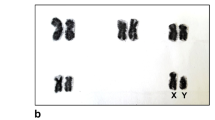Abstract
In four of the moth species investigated, viz. Witlesia murana, Scoparia arundinata (Pyraloidea), Bactra furfurana and B. lacteana (Tortricoidea) the metaphase plates of the first meiotic division of their oocytes show a trivalent in addition to the normal bivalents. It evidently has its rise in a transverse break in one of the conjugated chromosomes. Two sex chromatin bodies can be seen in the female somatic cells of three of these species, whereas other species with a normal XY bivalent have only one. These two sex chromatin bodies are unequal in size, and their sizes bear approximately the same relation to each other as do those of the two smaller chromosomes of the trivalent. The “broken” chromosome is evidently the Y chromosome. The sex chromosome designation for the four above-mentioned species is thus XY1Y2 for the females and XX for the males. The sex chromosomes of the four species are among the biggest of the respective complements. This supports the view that the big chromosome to be found in several Lepidoptera species is the sex chromosome. It seems that in animals with holokinetic chromosomes an excessive fragmentation is hindered, at least in the case of the sex chromosomes, by its deleterious effect on the balance of sex-determining genes.
Similar content being viewed by others
References
Bauer, H.: Chromosomenforschung. Fortschr. Zool. 7, 256–287 (1943).
—: Die kinetische Organisation der Lepidopteren-Chromosomen. Chromosoma (Berl.) 22, 101–125 (1967).
Federley, H.: Chromosomenzahlen finnländischer Lepidopteren. I. Rhopalocera. Hereditas (Lund) 24, 397–464 (1938).
Frizzi, G.: L'eteropicnosi come indice di riconoscimento dei sessi in Bombyx mori L. Ric. sci. 18, 1–7 (1948).
Hasimoto, H.: The role of the W-chromosome in the sex determination of Bombyx mori. Jap. J. Genet. 8, 245–247 (1933) (Not available in original).
Hughes-Schrader, S.: The chromosomes of mantids (Orthoptera: Manteidae) in relation to taxonomy. Chromosoma (Berl.) 4, 1–55 (1950).
John, B., Lewis, K. R.: The chromosome complement. Protoplasmatologia, vol. VI/ A, p. 1–206. Wien: Springer 1968.
Lesse, H. de: Spéciation et variation chromosomique chez les Lépidoptères Rhopalocères. Ann. Sci. Nat., Sér. XII, 2, 1–223 (1960).
Lewis, K. R., John, B.: The chromosomal basis of sex determination. Int. Rev. Cytol. 23, 277–379 (1968).
Seiler, J.: Das Verhalten der Geschlechtschromosomen bei Lepidopteren. Nebst einem Beitrag zur Kenntnis der Eireifung, Samenreifung und Befruchtung. Arch. Zellforsch. 13, 159–269 (1914).
: Geschlechtschromosomen-Untersuchungen an Psychiden. II. Die Chromosomenzyklen von Fumea casta und Talaeporia tubulosa. Arch. Zellforsch. 16, 19–46 (1921).
: Zytologische Vererbungsstudien an Schmetterlingen. I. Ergebnisse aus Kreuzungen von Schmetterlingrassen mit verschiedener Chromosomenzahl. Arch. Klaus-Stift. Vererb.-Forsch. 1, 63–117 (1925).
: Die Zytologie und Geschlechtsbestimmung der diploid parthenogenetischen Solenobia triquetrella. Arch. Klaus-Stift. Vererb.-Forsch. 28, 40–47 (1953).
Staiger, H., Bocquet, C.: Cytological demonstration of female heterogamety in isopods. Experientia (Basel) 10, 64–66 (1954).
—: Les chromosomes de la super-espèce Jaera marina (F.) et de quelques autres Janiridae (Isopodes Asellotes). Bull. Biol. France et Belg. 90, 1–32 (1956).
Suomalainen, E.: On the chromosomes of the Geometrid moth genus Cidaria. Chromosoma (Berl.) 16, 166–184 (1965).
—: Chromosome evolution in the Lepidoptera. Chromosomes today 2, 131–138 (1969).
—, Halkka, O.: The mode of meiosis in the Psyllina. Chromosoma (Berl.) 14, 489–510 (1963).
Tazima, Y.: Studies on chromosome aberations in the silkworm. II. Translocation involving second and W-chromosomes. Bull. Seric. Exp. Sta. Jap. 12, 109–181 (1944) (Not available in original).
—: The genetics of the silkworm. Bristol: Logos Press and Academic Press 1964.
Traut, W., Mosbacher, G. C.: Geschlechtschromatin bei Lepidopteren. Chromosoma (Berl.) 25, 343–356 (1968).
Wagner, H. O.: Samen- und Eireifung der Mehlmotte Ephestia kühniella. Z. Zellforsch. 12, 749–771 (1931).
White, M. J. D.: The evidence against polyploidy in sexually reproducing animals. Amer. Naturalist 80, 610–619 (1946).
—: Animal cytology and evolution, 2nd edit. Cambridge: Cambridge University press 1954.
—: Some general problems of chromosomal evolution and speciation in animals. Survey Biol. Progr. 3, 109–147 (1957).
—: Principles of karyotype evolution in animals. Genetics Today, Proc. XI Intern. Congr. Genet. 2, 391–397 (1964).
Winge, O.: Goldschmidt's theory of sex determination in Lymantria. J. Genet. 36, 81–89 (1937).
Author information
Authors and Affiliations
Additional information
Dedicated to Doctor Sally Hughes-Schrader on the occasion of her seventy-fifth birthday.
Rights and permissions
About this article
Cite this article
Suomalainen, E. On the sex chromosome trivalent in some Lepidoptera females. Chromosoma 28, 298–308 (1969). https://doi.org/10.1007/BF00284928
Received:
Accepted:
Issue Date:
DOI: https://doi.org/10.1007/BF00284928




